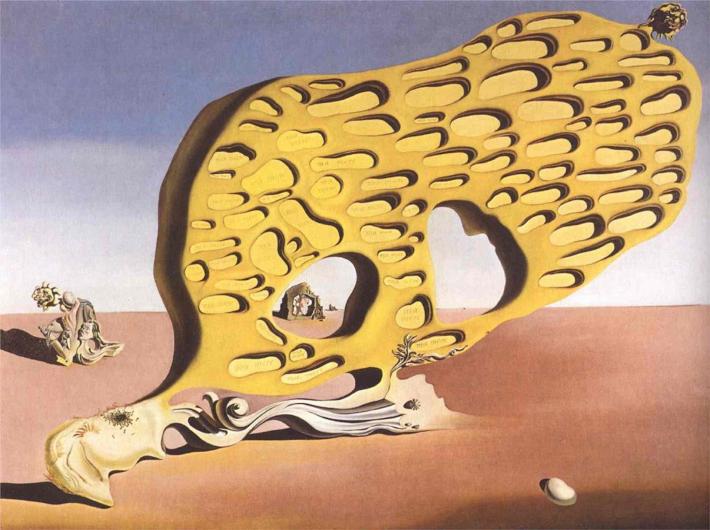
"Arrangement in Grey and Black No.1" (1871), Whistler's Mother
When American painter James Abbott McNeill Whistler’s (1834-1903) portrait of his mother, Anna Matilda McNeill Whistler, was exhibited at the Pennsylvania Academy of the Fine Arts in 1881, few could have predicted that it would become one of the most recognized images in the history of American painting.
In celebration of this upcoming Mother's Day, we want to reminisce on Whistler and other well-known artists who honored their mothers as subjects within their creative works.

Felipa Domènech Ferrés had a profound influence on her son, Spanish surrealist Salvador Dali (1904-1989). When Felipa died of uterine cancer in 1921, Dali was 16 years old, but was already well on his way to becoming the notoriously influential artist we now know today. When speaking of his mother, Dali noted, “My mother’s death was the greatest blow I had experienced in my life. I worshipped her...” Dali references his mother in his 1929 painting, The Enigma of My Desire or My Mother, My Mother, My Mother. Like most works by Dali, we are left to our own devices to figure out exactly what Dali had in mind when he titled this enigmatic work.

Whistler had not initially intended to paint his mom, but when his original model was a no-show, his mother graciously filled in. In 2023, the Philadelphia Museum of Art featured the iconic painting, formally referred to as Arrangement in Grey and Black No. 1: Portrait of the Artist’s Mother (1871), to celebrate the return of the painting to the city where it was first shown 142 years ago.
Whistler was inspired by Rembrandt’s sensitive etchings of his own mother, Neeltgen Willemsdr. van Zuytbroeck, whose aging face was tenderly captured both in paint and in line.

In turn, Whistler’s painting encouraged other artists to engage their mothers as muse and metaphor. Cecilia Beaux (1855-1942) is one Philadelphia-born artist whose portraits of women and their children rival John Singer Sargent (1856-1925) in their energetic brushwork. Her 1898 full-length, standing double portrait, Mother and Daughter (Mrs. Clement Acton Griscom and Frances C. Griscom), is a relatively rare depiction of an adult mother and daughter.

The great German Renaissance artist, Albrecht Dürer (1471-1528), had a particularly long and deep artist/muse relationship with his mother, Barbara Dürer. She bore an astounding 18 children and Albrecht traced the wear that this maternal effort wrought on her face and body in his early 1490 painting, and later in a charcoal-on-paper drawing dated 1514, when Barbara was around 63 years old.

Paintings of mothers and their children dominate the oeuvre of the beloved impressionist, Mary Cassatt (1844-1926). Although her parents objected to her becoming an artist, she frequently enlisted her mother to pose for her throughout her career. Her dramatic approach to composition saved her work from being overly saccharin.

French post-impressionist Paul Cézanne (1839-1906) credits his mother, Anne Elisabeth Honorine Aubert, with providing the encouragement he needed to become the artist we now consider foundational to modernism.
Before Cézanne developed the light and bright color pallet of his popular landscapes and still life paintings, his work relied on a dark umber base that is evident in this double portrait of his mother and younger sister, titled Overture to Tannhauser: The Artist’s Mother and Sister, from 1868.

Vincent Van Gogh’s (1853-1890) mother, Anna Carbentus van Gogh, was an amateur artist who introduced Vincent and her five other children to the joys of art-making, and also served occasionally as his model. In this case, the 1888 Portrait of the Artist’s Mother was produced from a black and white photograph. The intense green color that infuses the background and skin tones is an original invention. Anna’s expression seems slightly quizzical, perhaps a reflection of her feelings towards her son as she observed his slide into a state of mental confusion during his hospitalization in Arles in 1888-1889.

As we celebrate the myriad ways artists have depicted their mothers while they were alive, other artists also painted their moms after their death. James Ensor (1860-1949), most known for his macabre subjects and influence on surrealism, painted his Dead Mother in 1915. This work is literally a “still life” as the arrangement of medicine bottles in the foreground overshadows the ghost-like figure of Ensor’s mother, who already appears to be dissolving into space.

Felipa Domènech Ferrés had a profound influence on her son, Spanish surrealist Salvador Dali (1904-1989). When Felipa died of uterine cancer in 1921, Dali was 16 years old, but was already well on his way to becoming the notoriously influential artist we now know today. When speaking of his mother, Dali noted, “My mother’s death was the greatest blow I had experienced in my life. I worshipped her...” Dali references his mother in his 1929 painting, The Enigma of My Desire or My Mother, My Mother, My Mother. Like most works by Dali, we are left to our own devices to figure out exactly what Dali had in mind when he titled this enigmatic work.

Whistler had not initially intended to paint his mom, but when his original model was a no-show, his mother graciously filled in. In 2023, the Philadelphia Museum of Art featured the iconic painting, formally referred to as Arrangement in Grey and Black No. 1: Portrait of the Artist’s Mother (1871), to celebrate the return of the painting to the city where it was first shown 142 years ago.
Whistler was inspired by Rembrandt’s sensitive etchings of his own mother, Neeltgen Willemsdr. van Zuytbroeck, whose aging face was tenderly captured both in paint and in line.
Cynthia Close
Cynthia Close holds a MFA from Boston University, was an instructor in drawing and painting, Dean of Admissions at The Art Institute of Boston, founder of ARTWORKS Consulting, and former executive director/president of Documentary Educational Resources, a film company. She was the inaugural art editor for the literary and art journal Mud Season Review. She now writes about art and culture for several publications.























